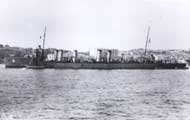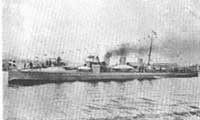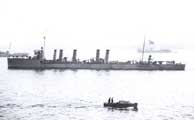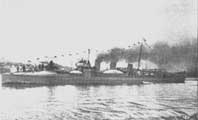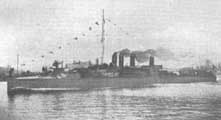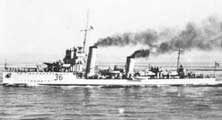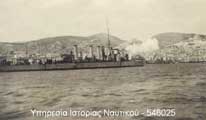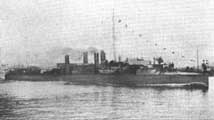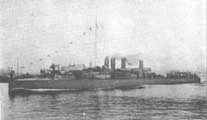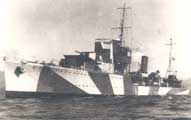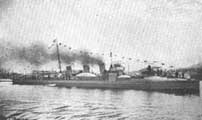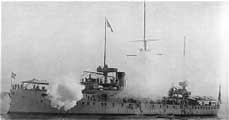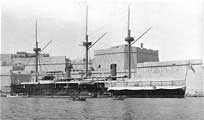.
The History of the Hellenic Navy (Greek: Πολεμικό Ναυτικό) begins with the birth of modern Greece, and due to the maritime nature of the country, this force has been the premier service of the Greek Armed Forces.
The navy during the Revolution
At the beginning of the Greek War of Independence, the naval forces of the Greeks was primarily the merchant fleet of the Saronic islanders from Hydra, Spetsai and Poros and also the islanders of Psara. Leading captains such as Constantine Kanaris of Psara, Andreas Miaoulis of Hydra and the notable woman captain, Laskarina Bouboulina of Spetsai became heroes in spectacular victories over the Turkish navy and it was due to their feats that Greece was immune to attack from the sea and the Revolution succeeded.[1]
The most significant battle of the Greek War of Independence was the Battle of Navarino in 1827, in which the Ottoman fleet was decisively defeated by the combined fleets of the Britain, France and the Russian Empire with the assistance of Greek fireships.
When Ioannis Capodistrias became governor of the newly-liberated Greece, the Greek fleet consisted of few remaining ships, which had participated in the war for independence. The first minister of "Naval affairs" was Constantine Kanaris and the most powerful ship of the fleet at that time, the frigate Hellas, had been constructed in the United States during the last years of the American revolution. The Navy established its headquarters at the island of Poros and the building of a new series of ships began at the naval base while old ships were gradually being retired. Furthermore, continuous efforts towards the education of officers were initiated. Young people were initially trained at the military school of Scholi Evelpidon and afterwards they were transferred to the navy, as there was no such thing as a Naval Academy.[2]
When Capodistrias was assassinated in 1831, Greece descended into anarchy with numerous areas, including Mani and Hydra in revolt. It was during this revolt that the Hellas was set on fire by Admiral Andreas Miaoulis where it was docked in Poros.[3]
The Royal Hellenic Navy of King Otto
When the new King Otto arrived in the Greek capital, Nafplion, in 1832 aboard the British warship HMS Madagascar, the Greek fleet consisted of 1 corvette, 3 brigs, 6 gollettes, 2 gunboats, 2 steamboats and a few more small vessels. The first Naval School was founded in 1846 on the Corvette Loudovikos and Leonidas Palaskas was assigned as the director. However the inefficient training of the officers, coupled with conflict between those who pursued modernization and those who were stalwarts of the traditions of veterans of the struggle for independence, resulted in a restricted and inefficient navy, which was limited to policing the sea and the pursuit of pirates.
During the 1850s, the more progressive elements of the navy won out and the fleet was augmented with more ships and in 1855, the first iron propeller-driven ships were ordered from England. These were the steamships Panopi, Pliksavra, Afroesa, and Sfendoni.[4]
Growth of the navy under King George
During the Cretan revolution in 1866, the ships of the Royal Hellenic Navy were in no condition to support the revolt. Such failure led to the government awakening to the problem of naval insufficiency and the adoption of a policy stating that: "The navy, as it represents a necessary weapon for Greece, should only be created for war and aim to victory." Because of this, the fleet was supplied with new and bigger ships, reflecting a number of innovations including the use of iron in shipbuilding industry and the invention of the torpedo; with these advances, the effectiveness and the appearance of the Hellenic Navy changed.
Meanwhile after 1878, because of the Russo-Turkish War and the need to expand the Greek navy, a new and larger naval base was established in the area of Faneromeni of Salamis and a few years later it was transferred to the area of Arapis where it remains today. At the same time the Naval Academy was founded and Ilias Kanellopoulos was made Director. A committee from France headed by Admiral Lejeune introduced a new, advanced naval organization and the methodological training of enlisted personnel through the establishment of a training school in the old building of the naval base in Poros.
During the government of Charilaos Trikoupis in 1889, the fleet was further increased with the acquisition of new ships:Hydra, Spetsai, and Psara from France. Thus, when Greece went to war in the Greco-Turkish War in 1897, the Hellenic Navy established its dominance in the Aegean Sea, however, it was unable to change the outcome of the war on land, which was a national humiliation.
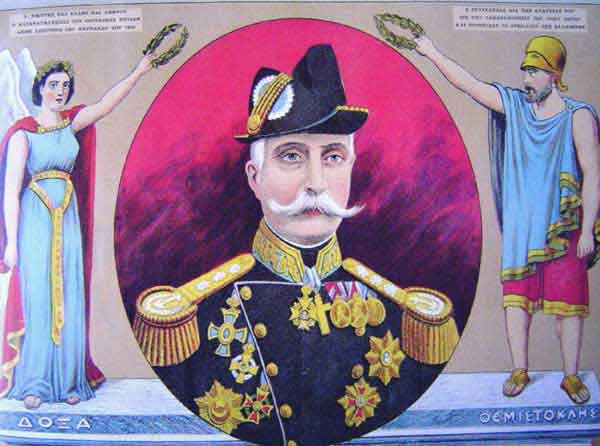
Pavlos Kountouriotis crowned by Glory and Themistocles after the Battle of Lemnos
In 1907, the Hellenic Navy General Staff (ΓΕΝ) was founded and its first chief was Captain Pavlos Kountouriotis. After the war in 1897, the Ottoman Empire embarked on a program of naval expansion for the Turkish fleet and as a response to that, in 1909, the battleship Georgios Averof was bought from Italy. In 1910, an English committee was sent, headed by Admiral Tuffnel in order to recommend improvements in the organization and training of the navy. The committee led to the adoption of the English style of management, organization and training especially in the area of strategy.
World War I and after:1914-1940
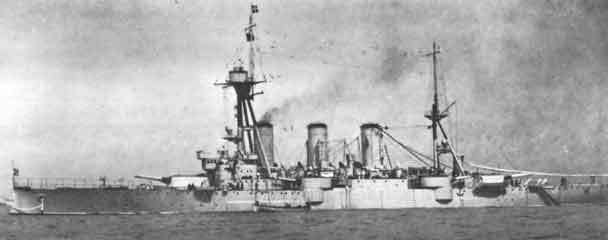
Battleship Averof, flagship of the Fleet
The modern Hellenic Navy was composed shortly before the Balkan Wars in the form of a destroyer and battleship fleet. Its mission was to safely transport troops and later, having a base at the Moudros port at Limnos, to provide marine supremacy in the Aegean, which was attained after the two successful naval battles at Elli (December 1912) and Lemnos (January 1913) against the Ottoman Navy.
The governments of that time gave priority to the Navy, so the battleships Limnos and Kilkis as well as the light cruiser Elli were purchased, and a number of destroyers were ordered. However in 1916, the pro-German actions of King Constantine I and Greece's unwillingness to participate in the Great War with the Allies led France to confiscate those new ships, so the strength of the fleet remained the same.
In July, 1917, after the formation of a pro-Entente government by Eleftherios Venizelos in Thessaloniki, those seized ships were released and the Hellenic Navy participated in naval operations in the Aegean with the Allies, mainly convoy escort and patrol missions. Later, it took part in operations in the Greco-Turkish War in Asia Minor. The Hellenic Navy in 1917 consisted of 2 battleships, 1 armored cruiser, 1 light cruiser, 14 destroyers, 2 submarines and 3 coastal defense ships.
In the 1930s defense funds declined, so the Navy received no new units apart from the modernization of four destroyers and six French submarines obtained in 1927.
World War II

The Adrias entering Alexandria's port
In 1938, Greece ordered four modern Greyhound class destroyers in English shipyards, making a serious step towards modernization. The outbreak of war in Europe, however, allowed only two to be delivered. Greece entered WW2 with a weak navy consisting of 10 destroyers, two battleships, two light cruisers and six submarines.
During the Greco-Italian War, the Navy took over convoy escort missions in the Ionian Sea and even embarked on a shore bombardment in the coast of Otrando. The most important role was given to the submarines, which although obsolete, managed to sink several Italian cargo ships.
But when Germany attacked Greece, the Hellenic Navy was literally decimated by the Luftwaffe, suffering the loss of 25 ships in April 1941. It was then decided to shift the remaining fleet (one battleship -the famous Greek cruiser Giorgios Averof-, three destroyers and five submarines) to Alexandria in Egypt.
As the war progressed, the number of Hellenic Navy vessels increased after the concession of several destroyers and submarines by the Royal Navy. The most important aspects of the Hellenic Navy's participation in World War II include the operations of the destroyer Vassilissa Olga which until she was sunk in Leros in September 23, 1943 was the most successful Allied destroyer in the Mediterranean Sea; the participation of two vessels in the Operation Overlord; and the unbelievable story of the destroyer Adrias, which while operating close to the coast of Calymnos in October 1943 hit a mine resulting to the loss of the vessels prow and blew the two-gun forward turret over the bridge. After some minor repairs at Chioumoultzouk bay in Turkey the Adrias managed to return to Alexandria in a 400-mile trip even though all the forepart of the ship, up to the bridge, was missing.
Modern Era 1950-1990

Hellenic Fleet on patrol
After World War II, the Royal Hellenic Navy was significantly strengthened by the concession of British and Italian ships. The organisation also changed in line with modern naval doctrines of that era, leaving aside the old battleships after the entrance into NATO. At the beginning of the 1950s, US military aid formed the core of the country's armed forces. The Royal Hellenic Navy received the first Bostwick-class destroyers which took on the name Beasts (Θηρία), while withdrawing the British ones.
The next significant change was during the early 1970s, when Greece was the first Mediterranean naval force to order missile-equipped fast attack craft (Combattante II) and the Type 209 submarines, whereas US military aid continued in the form of FRAM II class destroyers. In 1979, Hellenic Navy placed an order in the Netherlands for two modern Standard class frigates (the Elli class). These were the first acquisitions of new main surface vessels, rather than the use of second-hand ships, in almost four decades.
Present Status

Hydra class frigate
Hellenic Navy was enhanced to his maximum point during the last decade. The arrivals of Hydra class (MEKO® 200 HN) and more Standard class frigates along with the orders for more missile corvettes, Poseidon class Type 209 submarine submarines and naval helicopters allowed the retirement of the obsolete vessels. At the same time, Greece was the first Mediterranean country to receive guided missile destroyers, after the transfer of four Charles F. Adams class destroyers from the US Navy in 1992. But all four have since been decommissioned, since their electronics and missiles were considered not able to stand in a modern battlefield.
The advance continued when Greece ordered Type 214 submarines that feature an air-independent propulsion system, Sikorsky S-70B-6/10 Aegean Hawk helicopters and Project 1232.2 Zubr class hovercrafts from Russia.
Current plans include the modernization of Standard class frigates with new electronics and radar systems, the modernization of Glaukos and Poseidon class submarines with new sonars, electronics and air-independent propulsion engines (programs Neptune 1/2), while negotiations are being held with the US Navy for the concession of two Arleigh Burke class destroyers.
See also
Links
Zissis Fotakis, The Naval Importance of Greek Geographics Space and Fleet for the safety and the continuity of Hellenism 1000 BC - 1922 AD.
| Ancient Greece
Science, Technology , Medicine , Warfare, , Biographies , Life , Cities/Places/Maps , Arts , Literature , Philosophy ,Olympics, Mythology , History , Images Medieval Greece / Byzantine Empire Science, Technology, Arts, , Warfare , Literature, Biographies, Icons, History Modern Greece Cities, Islands, Regions, Fauna/Flora ,Biographies , History , Warfare, Science/Technology, Literature, Music , Arts , Film/Actors , Sport , Fashion --- |
Retrieved from "http://en.wikipedia.org/"
All text is available under the terms of the GNU Free Documentation License


